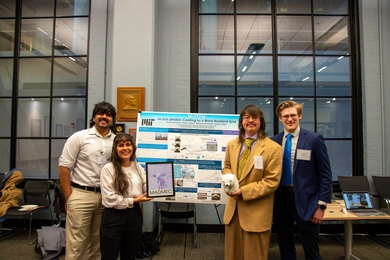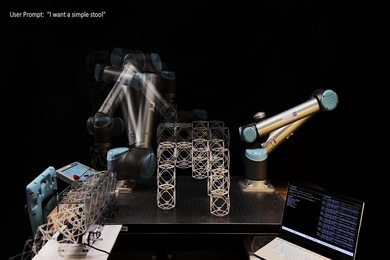At last week's Town Meeting to address questions on reengineering, President Charles M. Vest and other senior officers outlined progress on the work to increase efficiency and save money, and they assured community members that changes would be made as fairly as possible across the Institute.
Since the last Town Meeting in November 1993, more than 200 people have become involved in the reengineering effort and 12 teams have been formed to redesign various administrative processes. Redesigned processes for custodial services and hiring temporary secretarial help are already being tested, and plans to implement a new financial systems package and a training and development program are well along, said James D. Bruce, vice president for Information Systems and reengineering project manager.
Although it is costing money in the short term, reorganization as a result of reengineering will ultimately result in cost savings as well as more efficient work and delivery of services. "Our goal is very simple: to maintain and enhance the excellence of MIT in a time of great change and fiscal constraint," President Vest said.
Many of the questions submitted in advance or asked at the meeting focused on the impact of reengineering on salaries and personnel. In response to its budget deficit, the Institute has "tempered the level" of increases in wages and salaries, President Vest said, "and those increases will continue to be modest at best, as they are in virtually every sector of the country right now. But we don't plan to balance budgets at this point by gross decreases in salaries and wages. One thing that will definitely affect salaries and benefits in a negative manner is if we don't take the bull by the horns and solve the financial issues and learn how to work more efficiently and effectively."
About 400 MIT positions were cut in the early 1980s, "but it all grew up again over this decade," President Vest observed. During the next three or four years, a workforce reduction of about 600 will be necessary, "but I don't buy the hypothesis that it needs to be long-term employees who leave the Institute during this process," he said in response to an audience member who voiced concern over maintaining loyalty and morale among veteran support staff. While most segments of the community have experienced little or no staff increases, administrative staff has "grown very dramatically" in recent years, "and that tells us that that's an area on which we have to focus," he added.
Although Physical Plant and the Office of Laboratory Supplies have been among the first areas to feel the impact of reengineering, they will by no means be the only ones. "I have no preconceived notion of specific areas in the Institute where that comes from," Dr. Vest said, referring to staff reductions. "Before we're through with reengineering, we'll go through the entire administrative and support structure," added William R. Dickson, senior vice president and reengineering manager.
One major determinant of targets for downsizing is not MIT itself but the federal government, upon which the Institute depends for much of its research funding. "We're always vulnerable to policy decisions in Washington that may simply say `this overall research program is no longer going to be funded, or this area is going to be cut or enhanced,'" President Vest said.
Another audience member asked if MIT would be able to maintain its commitment to increasing representation of women and minorities during reengineering. He responded that that commitment would not change. "It is a deep concern of mine personally," he said. One of the six guiding principles of reengineering outlined earlier by Provost Mark Wrighton is that "there would be no retreat from our efforts to diversify the Institute-the faculty, the student body and the community in general." President Vest noted that he had recently reaffirmed MIT's affirmative action and equal opportunity policies, "and that's independent of what the government or public may or may not decide to do in this area."In response to a question about MIT's resources for training displaced workers, he said that new methods of delivering education to other than the normal student body, such as through distance learning and the World Wide Web, are being explored at various parts of MIT. "I don't know where that will lead, because we will not undertake any of these programs for the sole purpose of enhancing revenue," he said.
President Vest assured audience members of his and MIT's commitment to reengineering and its outcome. "I honestly feel that I am personally accountable for its success," he said. Corporation members must be satisfied that he is guiding MIT along the right fiscal course, and if they feel he is not doing so, "they'll let me know that in a direct manner and you'll be searching for a new president."
Asked what options were available if reengineering did not accomplish its goal of closing the budget gap, President Vest said, "We're going to succeed. We have not talked about scenarios if we don't succeed. We do not have Plan B in our hip pocket."
A version of this article appeared in MIT Tech Talk on May 10, 1995.





